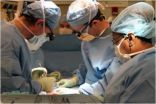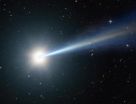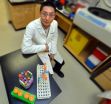(Press-News.org) Planck refines our knowledge of the Universe's composition and evolution
New maps provide excellent evidence for our standard model of cosmology
Planck dates Universe at 13.82 billion years old
Anomalies suggest that Universe may be different on scales larger than those we can directly observe
Most accurate values yet for the ingredients of the Universe, with normal matter contributing just 4.9% of the mass/energy density of the Universe and dark matter making up 26.8% - nearly a fifth more than the previous estimate.
Europe's Planck satellite - a flagship mission for the UK Space Agency - has compiled the most detailed map ever created of the cosmic microwave background (the relic radiation from the Big Bang). The new map refines our understanding of the Universe's composition and evolution, and unveils new features that could challenge the foundations of our current understanding of its evolution.
The image is based on the initial 15.5 months of data from Planck and is the mission's first all-sky picture of the oldest light in our Universe, imprinted on the sky when it was just 380 000 years old. This cosmic microwave background (CMB) shows tiny temperature fluctuations that correspond to regions of slightly different densities at very early times, representing the seeds of all future structure: the stars and galaxies of today.
Overall, the information extracted from Planck's new map provides an excellent confirmation of the standard model of cosmology at an unprecedented accuracy, setting a new benchmark for our knowledge of the contents of the Universe.
Dr Chris Castelli, Acting Director of Science, Technology and Exploration at the UK Space Agency, said, "We're immensely proud to be playing a key role in this amazing discovery. With its ability to make such detailed and accurate observations, Planck is helping us to place the vital pieces of a jigsaw that could give us a full picture of the evolution of our Universe, rewriting the textbooks along the way."
"The CMB temperature fluctuations detected by Planck confirm once more that the relatively simple picture provided by the standard model is an amazingly good description of the Universe," explains George Efstathiou of the University of Cambridge.
The properties of the hot and cold regions of the map provide information about the composition and evolution of the Universe. Normal matter that makes up stars and galaxies contributes just 4.9% of the mass/energy density of the Universe. Dark matter, which has thus far only been detected indirectly by its gravitational influence, makes up 26.8%, nearly a fifth more than the previous estimate. Conversely, dark energy, a mysterious force thought to be responsible for accelerating the expansion of the Universe, accounts for slightly less than previously thought, at around 69%.
The Planck data also set a new value for the rate at which the Universe is expanding today, known as the Hubble constant. At 67.3 km/s/Mpc, this is significantly different from the value measured from relatively nearby galaxies. This somewhat slower expansion implies that the Universe is also a little older than previously thought, at 13.8 billion years.
The analysis also gives strong support for theories of "inflation", a very brief but crucial early phase during the first tiny fraction of a second of the Universe's existence. As well as explaining many properties of the Universe as a whole, this initial expansion caused the ripples in the CMB that we see today.
Although this primordial epoch can't be observed directly, the theory predicts a set of very subtle imprints on the CMB map. Previous experiments have not been able to confidently detect these subtle imprints, but the high resolution of Planck's map confirms that the tiny variations in the density of the early Universe match those predicted by inflation.
'The sizes of these tiny ripples hold the key to what happened in that first trillionth of a trillionth of a second. Planck has given us striking new evidence that indicates they were created during this incredibly fast expansion, just after the Big Bang', explained Joanna Dunkley of the University of Oxford.
But because the precision of Planck's map is so high, it also reveals some peculiar unexplained features that may well require new physics to be understood. Amongst the most surprising findings are that the fluctuations in the CMB over large scales do not match those predicted by the standard model. This anomaly adds to those observed by previous experiments, and confirmed by Planck, including an asymmetry in the average temperatures on opposite hemispheres of the sky, and a cold spot that extends over a patch of sky that is much larger than expected.
One way to explain the anomalies is to propose that the Universe is in fact not the same in all directions on a larger scale than we can observe. In this scenario, the light rays from the CMB may have taken a more complicated route through the Universe than previously understood, resulting in some of the unusual patterns observed today.
"Our ultimate goal would be to construct a new model that predicts the anomalies and links them together. But these are early days; so far, we don't know whether this is possible and what type of new physics might be needed. And that's exciting," says Professor Efstathiou.
Professor John Womersley, Chief Executive of the Science and Technology Facilities Council (STFC), said, "Planck has given us an amazing picture of the very earliest moments of the Universe. These results are the culmination of many years of work by UK scientists and engineers supported by STFC. This kind of project can sometimes seem expensive but the payoff in science and technology more than justifies the investment we've made.'"
###
Notes for Editors
Images and animations:
Cosmic recipe pie chart: http://www.bis.gov.uk/assets/ukspaceagency/images-2013/planck/planck-cosmic-recipe-pie-chart.jpg
Planck's history of the universe: http://www.bis.gov.uk/assets/ukspaceagency/images-2013//planck/planck-history-of-universe.jpg
Anomalies: http://www.bis.gov.uk/assets/ukspaceagency/images-2013/planck/anomalies-sieve.jpg
CMB: http://www.bis.gov.uk/assets/ukspaceagency/images-2013/planck/cosmic-microwave-background.jpg
Toolkit: http://www.bis.gov.uk/assets/ukspaceagency/docs-2013/planck-toolkit.pdf
UK involvement in Planck
The UK is playing a major role in the Planck mission. A number of UK institutes and companies form part of the consortium that built the two focal plane instruments, HFI and LFI. The Jodrell Bank Observatory at The University of Manchester produced critical elements of the LFI receiver modules.
Cardiff University, STFC RAL and SEA were involved with hardware development for HFI, while various UK research groups including Imperial College London, University of Cambridge, and University of Oxford form the London Planck Analysis Centre and Cambridge Planck Analysis Centre. These groups are involved with data analysis and simulation for the HFI data analysis and simulation software
Planck all-sky image and the CMB
The all-sky picture is of the oldest light in our Universe, imprinted on the sky when it was just 380 000 years old.
At that time, the young Universe was filled with a hot dense soup of interacting protons, electrons and photons at about 2700ºC. When the protons and electrons joined to form hydrogen atoms, the light was set free. As the Universe has expanded, this light today has been stretched out to microwave wavelengths, equivalent to a temperature of just 2.7 degrees above absolute zero.
This 'cosmic microwave background' – CMB – shows tiny temperature fluctuations that correspond to regions of slightly different densities at very early times, representing the seeds of all future structure: the stars and galaxies of today.
According to the standard model of cosmology, the fluctuations arose immediately after the Big Bang and were stretched to cosmologically large scales during a brief period of accelerated expansion known as inflation.
Planck was designed to map these fluctuations across the whole sky with greater resolution and sensitivity than ever before. By analysing the nature and distribution of the seeds in Planck's CMB image, we can determine the composition and evolution of the Universe from its birth to the present day.
Planck data
A series of scientific papers describing the new results will be published on 22 March.
The new data from Planck are based on the first 15.5 months of its all-sky surveys. Launched in 2009, Planck was designed to map the sky in nine frequencies using two state-of-the-art instruments: the Low Frequency Instrument (LFI), which includes the frequency bands 30 GHz, and the High Frequency Instrument (HFI), which includes the frequency bands 100� GHz. HFI completed its survey in January 2012, while LFI continues to operate.
Planck's first all-sky image was released in 2010 and the first scientific data were released in 2011. Since then, scientists have been extracting the foreground emissions that lie between us and the Universe's first light to reveal the CMB presented in this release. The next set of cosmology data will be released in early 2014.
Contact:
Julia Short
Press Officer
UK Space Agency
Tel: +44 (0)1793 418069
Mobile: +44 (0)7770 276721
Email: julia.short@ukspaceagency.bis.gsi.gov.uk
UK Space Agency
The UK Space Agency is at the heart of UK efforts to explore and benefit from space. It is responsible for all strategic decisions on the UK civil space programme and provides a clear, single voice for UK space ambitions.
The Agency is responsible for ensuring that the UK retains and grows a strategic capability in the space-based systems, technologies, science and applications. It leads the UK's civil space programme in order to win sustainable economic growth, secure new scientific knowledge and provide benefits to all citizens.
The UK Space Agency:
Co-ordinates UK civil space activity
Encourages academic research
Supports the UK space industry
Raises the profile of UK space activities at home and abroad
Increases understanding of space science and its practical benefits
Inspires our next generation of UK scientists and engineers
Licences the launch and operation of UK spacecraft
Promotes co-operation and participation in the European Space programme
Planck challenges our understanding of the Universe
Planck refines our knowledge of the Universe's composition and evolution
2013-03-21
ELSE PRESS RELEASES FROM THIS DATE:
What you eat before surgery may affect your recovery
2013-03-21
BOSTON, MA—According to a new study, the last few meals before surgery might make a difference in recovery after surgery. Fat tissue is one of the most dominant components that make up the body, and fat tissue is always traumatized during major surgery.
Researchers at Brigham and Women's Hospital (BWH) found that this direct trauma greatly impacts the chemical balance of fat tissue—chemicals that are known to communicate with nearby and distant organs. In the study, mice that consumed a typical Western, high-fat diet showed an exaggerated imbalanced response. Importantly, ...
Researchers tackle physician challenge of correctly ordering laboratory tests
2013-03-21
(Boston) – A new study involving researchers from the Boston University School of Medicine (BUSM) has identified barriers that clinicians face in correctly ordering appropriate laboratory tests and highlights some solutions that may simplify this process and improve patient outcomes. The study, published in the March 2013 issue of the Journal of General Internal Medicine, was led by Elissa Passiment, EdM, of the American Society for Clinical Laboratory Science and James L. Meisel, MD, associate professor of medicine at BUSM.
Passiment, Meisel and colleagues identified ...
Global nitrogen availability consistent for past 500 years, linked to carbon levels
2013-03-21
MANHATTAN -- A Kansas State University research team has found that despite humans increasing nitrogen production through industrialization, nitrogen availability in many ecosystems has remained steady for the past 500 years. Their work appears in the journal Nature.
"People have been really interested in nitrogen in current times because it's a major pollutant," said Kendra McLauchlan, assistant professor of geography and director of the university's Paleoenvironmental Laboratory. "Humans are producing a lot more nitrogen than in the past for use as crop fertilizer, ...
'Gene Therapy for Human Disease: Clinical Advances and Challenges'
2013-03-21
Philadelphia, PA, March 21, 2013 – The April issue of Translational Research examines the progress and outlook of gene therapy research, with a specific focus on the clinical applicability of gene therapy today. Research articles included in the special issue highlight current studies that, after decades of trial and error, may provide evidence for a clear path of treatment and cure for many diseases. There are more than 1,800 genetic disorders known in humans, and only a small fraction of these can be treated and even fewer cured. Some of these disorders are exceedingly ...
'Sideline quasars' helped to stifle early galaxy formation, says CU-Boulder study
2013-03-21
University of Colorado Boulder astronomers targeting one of the brightest quasars glowing in the universe some 11 billion years ago say "sideline quasars" likely teamed up with it to heat abundant helium gas billions of years ago, preventing small galaxy formation.
CU-Boulder Professor Michael Shull and Research Associate David Syphers used the Hubble Space Telescope to look at the quasar -- the brilliant core of an active galaxy that acted as a "lighthouse" for the observations -- to better understand the conditions of the early universe. The scientists studied gaseous ...
Reward linked to image is enough to activate brain's visual cortex
2013-03-21
Once rhesus monkeys learn to associate a picture with a reward, the reward by itself becomes enough to alter the activity in the monkeys' visual cortex. This finding was made by neurophysiologists Wim Vanduffel and John Arsenault (KU Leuven and Harvard Medical School) and American colleagues using functional brain scans and was published recently in the leading journal Neuron.
Our visual perception is not determined solely by retinal activity. Other factors also influence the processing of visual signals in the brain. "Selective attention is one such factor," says Professor ...
Do disruptions in brain communication have a role in autism?
2013-03-21
New Rochelle, NY, March 21, 2013—A new study of patterns of brain communication in toddlers with autism shows evidence of aberrant neural communication even at this relatively early stage of brain development. The results are presented in an article in Brain Connectivity, a bimonthly peer-reviewed journal from Mary Ann Liebert, Inc., publishers. The article is available free on the Brain Connectivity website at http://www.liebertpub.com/brain.
A team of researchers from The Netherlands (University Medical Center Utrecht and Utrecht University, Radboud University Nijmegen ...
Cancer drug shortages mean higher costs and greater risk for patients
2013-03-21
A national survey of health professionals showed that drug shortages are taking a heavy toll on cancer patients, forcing treatment changes and delays that for some patients meant worse outcomes, more therapy-related complications and higher costs. St. Jude Children's Research Hospital investigators played an important role in the study.
The survey queried oncology pharmacists and others involved in managing cancer drug shortages for academic medical centers, community hospitals and other cancer treatment facilities nationwide. Of the 243 individuals who completed the ...
Scientists identify gene that is consistently altered in obese individuals
2013-03-21
AUGUSTA, Ga. – Food and environment can chemically alter your gene function and scientists have identified a gene that is consistently altered in obesity.
The gene LY86 was among a group of 100 genes identified as likely contributors to obesity through genome-wide association studies comparing the DNA of thousands of obese and lean individuals, said Dr. Shaoyong Su, genetic epidemiologist at the Medical College of Georgia at Georgia Regents University.
Su looked at progressively larger groups of obese versus lean individuals and found LY86 consistently and highly chemically ...
Researchers' new method may sharpen microscopic images
2013-03-21
UT Dallas researchers are developing a new low-light imaging method that could improve a number of scientific applications, including the microscopic imaging of single molecules in cancer research.
Electrical engineering professor Dr. Raimund Ober and his team recently published their findings in the journal Nature Methods. In the journal, they describe a method which minimizes the deterioration of images that can occur with conventional imaging approaches.
"Any image you take of an object is translated by the camera into pixels with added electronic noise," Ober said. ...
LAST 30 PRESS RELEASES:
The Ceramic Society of Japan’s Oxoate Ceramics Research Association launches new international book project
Heart-brain connection: international study reveals the role of the vagus nerve in keeping the heart young
Researchers identify Rb1 as a predictive biomarker for a new therapeutic strategy in some breast cancers
Survey reveals ethical gaps slowing AI adoption in pediatric surgery
Stimulant ADHD medications work differently than thought
AI overestimates how smart people are, according to HSE economists
HSE researchers create genome-wide map of quadruplexes
Scientists boost cell "powerhouses" to burn more calories
Automatic label checking: The missing step in making reliable medical AI
Low daily alcohol intake linked to 50% heightened mouth cancer risk in India
American Meteorological Society announces Rick Spinrad as 2026 President-Elect
Biomass-based carbon capture spotlighted in newly released global climate webinar recording
Illuminating invisible nano pollutants: advanced bioimaging tracks the full journey of emerging nanoscale contaminants in living systems
How does age affect recovery from spinal cord injury?
Novel AI tool offers prognosis for patients with head and neck cancer
Fathers’ microplastic exposure tied to their children’s metabolic problems
Research validates laboratory model for studying high-grade serous ovarian cancer
SIR 2026 delivers transformative breakthroughs in minimally invasive medicine to improve patient care
Stem Cell Reports most downloaded papers of 2025 highlight the breadth and impact of stem cell research
Oxford-led study estimates NHS spends around 3% of its primary and secondary care budget on the health impacts of heat and cold in England
A researcher’s long quest leads to a smart composite breakthrough
Urban wild bees act as “microbial sensors” of city health.
New study finds where you live affects recovery after a hip fracture
Forecasting the impact of fully automated vehicle adoption on US road traffic injuries
Alcohol-related hospitalizations from 2016 to 2022
Semaglutide and hospitalizations in patients with obesity and established cardiovascular disease
Researchers ‘listen in’ to embryo-mother interactions during implantation using a culture system replicating the womb lining
How changing your diet could help save the world
How to make AI truly scalable and reliable for real-time traffic assignment?
Beyond fragmented markets: A new framework for efficient and stable ride-pooling
[Press-News.org] Planck challenges our understanding of the UniversePlanck refines our knowledge of the Universe's composition and evolution



